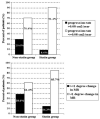Effect of hydroxymethylglutaryl coenzyme-a reductase inhibitors on the long-term progression of rheumatic mitral valve disease
- PMID: 20439789
- PMCID: PMC3263343
- DOI: 10.1161/CIRCULATIONAHA.109.891598
Effect of hydroxymethylglutaryl coenzyme-a reductase inhibitors on the long-term progression of rheumatic mitral valve disease
Abstract
Background: At present, no medical therapy is known to affect the progression of rheumatic mitral stenosis (MS). We sought to assess the effect of statin treatment on long-term progression of MS in a large population.
Methods and results: From our 20-year database, we identified all patients with rheumatic MS with > or =2 echocardiographies > or =1 year apart. Exclusion criteria were previous intervention on the mitral valve, more than moderate aortic regurgitation, or symptoms at first examination. The study sample included 315 patients (mean age, 61+/-12 years; 224 women); 35 patients (11.1%) were treated with statins, and 280 (88.9%) were not. Mean follow-up period was 6.1+/-4.0 years (range, 1 to 20). The rate of decrease in mitral valve area was significantly lower in the statin group compared with the untreated group (0.027+/-0.056 versus 0.067+/-0.082 cm(2)/y; P=0.005). The annualized change in mean transmitral gradient was lower in statin-treated patients (0.20+/-0.59 versus 0.58+/-0.96 mm Hg/y; P=0.023). The prevalence of fast MS progression (annual change in mitral valve area >0.08 cm(2)) was significantly lower in the statin group (P=0.008). An increase in systolic pulmonary artery pressure of >10 mm Hg was found in 17% of patients in the statin group versus 40% of untreated patients (P=0.045).
Conclusions: Our study shows a significantly slower progression of rheumatic MS in patients treated with statins. These findings could have an important impact in the early medical therapy of patients with rheumatic heart disease.
Figures
References
-
- Carapetis JR, McDonald M, Wilson NJ. Acute rheumatic fever. Lancet. 2005;366:155–168. - PubMed
-
- Rheumatic Fever and Rheumatic Heart Disease: Report of WHO Expert Consultation, Geneva, 29 October--1 November 2001. World Health Organization; Geneva, Switzerland: 2004. Technical Report Series 923.
-
- Vahanian A, Baumgartner H, Bax J, Butchart E, Dion R, Filippatos G, Flachskampf F, Hall R, Iung B, Kasprzak J, Nataf P, Tornos P, Torracca L, Wenink A, Task Force on the Management of Valvular Hearth Disease of the European Society of Cardiology. ESC Committee for Practice Guidelines Guidelines on the management of valvular heart disease: the Task Force on the Management of Valvular Heart Disease of the European Society of Cardiology. Eur Heart J. 2007;28:230–268. - PubMed
-
- Mohler ER, III, Gannon F, Reynolds C, Zimmerman R, Keane MG, Kaplan FS. Bone formation and inflammation in cardiac valves. Circulation. 2001;103:1522–1528. - PubMed
MeSH terms
Substances
Grants and funding
LinkOut - more resources
Full Text Sources
Other Literature Sources
Medical


